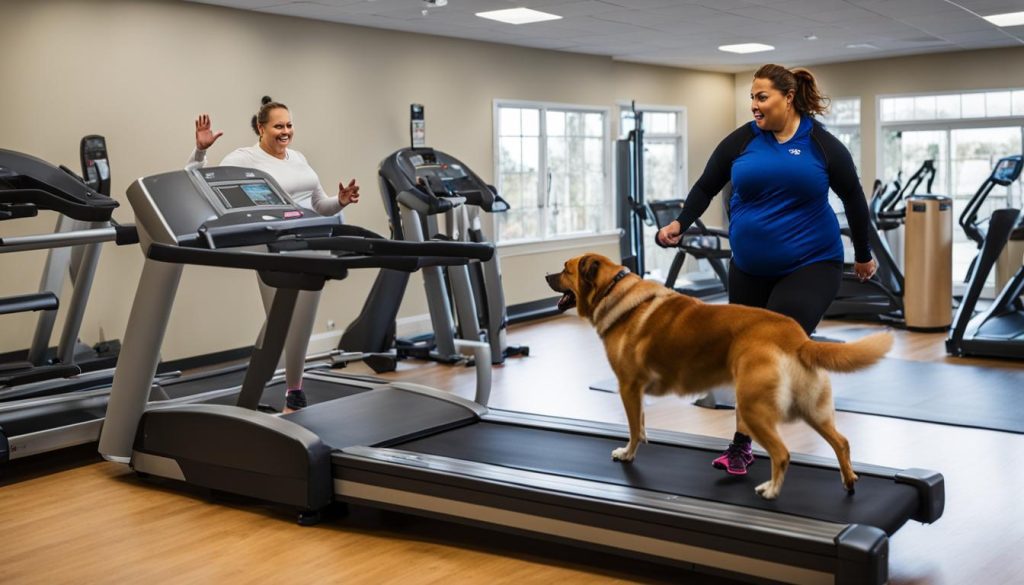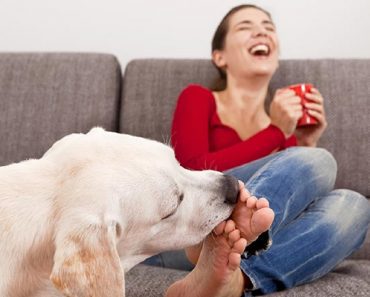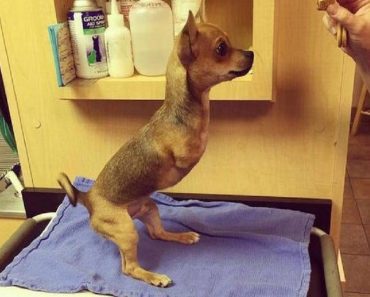According to multiple sources, including CBS News and the Association for Pet Obesity Prevention, dog obesity is a serious concern in the United States. It is estimated that 45-60% of pet dogs in the country are overweight, which can lead to various health problems such as diabetes, heart disease, kidney disease, and arthritis. As responsible pet owners, it is our duty to help our furry friends maintain a healthy weight and lead a happy, active life.
- It is estimated that 45-60% of pet dogs in the United States are overweight.
- Dog obesity can lead to serious health problems.
- We have a responsibility to help our pets maintain a healthy weight.
- Overweight dogs are more prone to diabetes, heart disease, kidney disease, and arthritis.
- By following proper weight management techniques, we can improve our dog’s quality of life.
Is Your Dog Overweight?
The first step in helping your dog lose weight is to determine if they are overweight. This can be done through a simple rib check and waist check.
- You should be able to feel your dog’s ribs but not see them. Place your hands gently on your dog’s sides and run your fingers along their ribcage. If you can easily feel the ribs without pressing hard, it indicates a healthy weight.
- Their abdomen should be “tucked up” behind the ribs. When looking at your dog from the side, there should be a noticeable upward slope from their ribcage to their hind legs.
- From the side, they should have a defined waist. Stand beside your dog and observe their body shape. There should be a visible narrowing between their ribcage and hips.
If your dog does not meet these criteria, they may be overweight and in need of weight loss. It is important to address their weight to ensure their overall health and well-being.
Rule Out Medical Conditions
Before starting a weight loss program for your dog, it is important to consult with a veterinarian to rule out any underlying medical conditions that may be contributing to their weight gain. Some underlying medical conditions, such as hypothyroidism or Cushing’s disease, can cause weight gain or difficulty losing weight in dogs. By identifying and addressing these underlying conditions, you can ensure that your weight loss efforts are effective and safe for your furry friend.
Your veterinarian will conduct a thorough examination and may perform diagnostic tests to determine if there are any health issues affecting your dog’s weight. These tests may include blood work, hormone testing, or imaging studies. It is essential to follow your vet’s advice and guidance during this process.
Once any underlying medical conditions have been ruled out, your veterinarian can provide you with the necessary guidance and create an individualized weight loss plan for your dog. This plan may include specific dietary recommendations, exercise guidelines, and regular check-ups to monitor progress. Every dog is unique, and working closely with your veterinarian will ensure that your weight loss efforts are tailored to your dog’s specific needs.
Why Consult a Veterinarian?
Consulting a veterinarian is crucial because they have the medical expertise and knowledge to diagnose and treat underlying medical conditions in dogs. They can determine if there are any health issues affecting your dog’s weight and provide appropriate treatment or management strategies. Additionally, a veterinarian can guide you in making informed decisions about your dog’s diet, exercise, and overall health. Their professional input will help you develop a comprehensive weight loss plan that prioritizes your dog’s well-being.
Remember, your dog’s weight loss journey should be approached with caution and under the supervision of a veterinarian. They will help you make the necessary adjustments to ensure that your dog’s weight loss is gradual, healthy, and sustainable.
Diet
A major component of helping your dog lose weight is their diet. It is important to choose a well-rounded food that meets their dietary needs, taking into consideration their breed, size, age, and activity level.
When selecting a dog weight loss diet, opt for a low-calorie, high-fiber formula. This type of diet can help your dog feel full while still providing the necessary nutrients. High-fiber foods are also beneficial for promoting healthy digestion and regulating blood sugar levels.
Portion control is essential to ensure your dog is not consuming more calories than they need. Consult with your veterinarian to determine the appropriate portion size for your dog’s weight loss goals. You may need to reduce the amount of food your dog is currently consuming to create a calorie deficit for weight loss.
Consider feeding your dog smaller, more frequent meals throughout the day to help manage their hunger. This can be achieved by dividing their daily food allowance into multiple servings.
Introduce dietary changes gradually to allow your dog’s digestive system to adjust. Sudden changes in diet can lead to gastrointestinal upset. Monitor your dog’s weight and body condition regularly and make adjustments to their diet as needed.
Key Points:
- Choose a well-rounded food that meets your dog’s dietary needs.
- Select a low-calorie, high-fiber diet to help your dog feel full while providing necessary nutrients.
- Control portion sizes to create a calorie deficit for weight loss.
- Feed smaller, more frequent meals to manage hunger.
- Monitor your dog’s weight and body condition and make adjustments to their diet as needed.
Exercise
Along with a healthy diet, regular exercise is crucial for helping your dog lose weight. Daily physical activity provides numerous benefits, including burning extra calories and improving overall fitness. It’s also a great way to bond with your furry friend and keep them mentally stimulated.
When it comes to exercises for overweight dogs, start with low-impact activities that are gentle on their joints. This can include daily walks or swimming sessions if your dog enjoys the water. These activities help increase their heart rate, boost metabolism, and burn calories.
Another fun exercise option is playing games of fetch. This engages your dog both physically and mentally, encouraging them to run and retrieve the toy or ball. Try using toys that make your dog work a bit harder, like puzzle toys or treat-dispensing balls, to add an extra challenge and increase their exercise intensity.
Gradually increase the intensity and duration of exercise over time to avoid injury or strain. Just like humans, dogs need to build up their stamina. You can do this by extending the duration of walks or increasing the number of repetitions during playtime.
It’s important to tailor the exercise routine to your dog’s energy levels and physical limitations. If your dog has any existing health conditions or mobility issues, consult with your veterinarian to create a suitable exercise plan. They can provide specific guidance based on your dog’s needs and help you determine the optimal level of activity.

Conclusion
Helping your dog lose weight is a gradual process that requires dedication and consistency. By following a structured dog weight loss program, you can set achievable long-term weight loss goals and ensure a healthy lifestyle for your furry companion.
Remember to consult with a veterinarian to create a personalized weight loss plan tailored to your dog’s specific needs. Regular check-ins and monitoring will allow you to track their progress and make necessary adjustments to their diet and exercise routine.
By promoting a healthy lifestyle, you can improve your dog’s overall health and quality of life. While it may take some time to see significant results, sticking to the program will help your beloved pet achieve and maintain a healthy weight for years to come.
FAQ
How can I determine if my dog is overweight?
You can determine if your dog is overweight by performing a rib check and waist check. You should be able to feel your dog’s ribs but not see them, and their abdomen should be “tucked up” behind the ribs. From the side, they should have a defined waist.
Should I consult a veterinarian before starting a weight loss program for my dog?
Yes, it is important to consult with a veterinarian before starting a weight loss program for your dog. They can rule out any underlying medical conditions that may be contributing to their weight gain and create an individualized weight loss plan based on your dog’s specific needs.
What should I feed my overweight dog?
It is important to choose a well-rounded food that meets your dog’s dietary needs. Take into consideration their breed, size, age, and activity level. Portion control is also essential, and it may be necessary to reduce the amount of food your dog is currently consuming. A low-calorie, high-fiber diet can help your dog feel full while still providing necessary nutrients.
What kind of exercise should I do with my overweight dog?
Regular exercise is crucial for helping your dog lose weight. Daily physical activity, such as walks or games of fetch, can help burn extra calories and improve overall fitness. Gradually increase the intensity and duration of exercise to avoid injury or strain. Tailor the exercise routine to your dog’s energy levels and physical limitations.
How long does it take for a dog to lose weight?
Helping your dog lose weight is a gradual process that requires dedication and consistency. It may take several months to see significant results. But sticking to a weight loss program can improve your dog’s overall health and quality of life.






